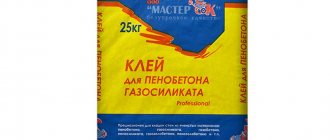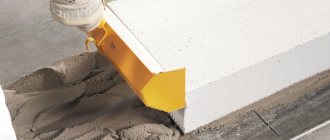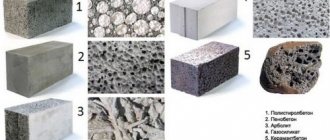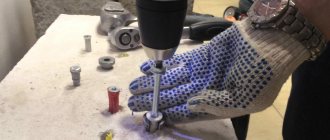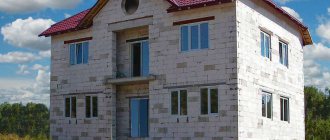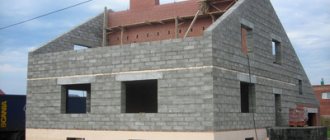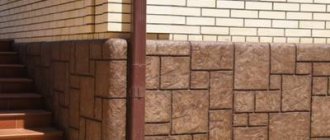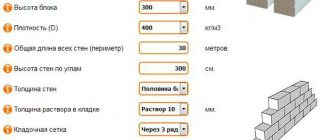Redevelopment of an apartment or private house is required in half of the cases of major repairs. Such a popular procedure is performed from any block materials and bricks, but one of the best options is foam block.
Partitions made of foam blocks perform sound and heat insulation functions, do not lead to a significant increase in the weight of the structure and are easy to lay. To build a wall correctly, you should take into account all possible problems, prepare well and carry out the laying in accordance with technical rules.
The structure of a foam concrete partition
Foam blocks for partitions are laid according to a similar principle as brick. Initially, it is worth determining whether the partition foam block is suitable for the task. The material is based on foam concrete with high insulating qualities, but low load-bearing abilities. It is practical to use and durable.
Partitions made of foam blocks
The characteristics of foam concrete blocks give the material numerous advantages:
- when laying partitions from foam blocks, the masonry is done very simply and with minimal time, the process is 2 times faster than building from brick;
- It has good sound insulation and heat insulation properties and is easy to process. If the dimensions of the foam blocks for partitions are not suitable for the intended purpose, then you can always easily cut off part of the element;
- It’s easy to drill a hole inside for wires or pipes;
- helps to realize the design idea:
- multifaceted shapes, rounded arches, etc., due to its flexibility in processing with a hacksaw;
- due to the large thickness of the partitions and the blocks themselves, a doorway can be cut into them;
- foam blocks, and foam concrete in general, are suitable for decorative treatments:
- sanding, laying heavy tiles, plastering surfaces, applying wallpaper, etc.;
- resistant to temperature changes, chemical and biological liquids, moisture, and exposure to ultraviolet light;
- the low price of the material makes it accessible to the masses;
- does not lead to a large load on the foundation or supports.
If we compare various concrete blocks of any grade of cement and foam blocks, the latter is the most popular due to the listed advantages. It is suitable for masonry in commercial, office buildings, houses and apartments.
When laying partitions from foam blocks, the masonry is done very simply and with minimal time.
The disadvantage of the material is the likelihood of obtaining specimens with a curved shape. High demands are placed on the surfaces of blocks, but only in relation to elements manufactured in production conditions, where GOST applies to sizes and shapes. If the purchase is made in underground workshops, it is better to buy more than the required number of blocks.
Soundproofing of aerated concrete
Although sellers of gas silicate blocks talk about high sound insulation performance, they greatly exaggerate. Even a standard block 200 mm thick conducts sounds and noise well, and thinner partition blocks even more so.
Comparative characteristics of sound insulation of partitions made of different materials
According to standards, the sound resistance of partitions should not be lower than 43 dB, and it is better if it is higher than 50 dB. This will provide you with silence.
Sound insulation standards for different rooms
To get an idea of how “noisy” gas silicate blocks are, we present a table with standard indicators of sound resistance of blocks of different densities and different thicknesses.
Sound absorption coefficient of aerated concrete blocks
As you can see with the block, at 100mm thick it falls slightly short of the lowest requirement. Therefore, when finishing aerated concrete, you can increase the thickness of the finishing layer in order to “reach” the standard. If normal sound insulation is required, the walls are additionally sheathed with mineral wool. This material is not soundproofing, but it reduces noise by approximately 50%. As a result, sounds are almost inaudible. Specialized soundproofing materials have the best performance, but when choosing them, you need to look at their vapor permeability characteristics so as not to trap moisture inside the gas silicate.
If you need absolutely “quiet” walls, experts advise installing two thin partitions with a distance of 60–90 mm, which should be filled with sound-absorbing material.
Types of foam blocks: by size and thickness
There are varieties of materials for installing partitions. Choosing the right type will help make the wall strong enough, durable and well-insulated. They differ in density; denser options are used for load-bearing walls, and internal walls are made of looser material.
To select a material, it is worth clarifying the location of the partition. If you plan to install it on a balcony, it is important to ensure the least weight of the structure. If you plan to install it in a room, you should take into account the load and density of the blocks. For external walls, you should select elements with a grade of at least D300 or higher. Partitions can be constructed from foam blocks of strength D150-D300.
According to the manufacturing method, they are distinguished:
Non-autoclaved
Suitable for small organizations, as it is of low quality. There is practically no production control; the material hardens naturally. Foam concrete gains strength unevenly, which changes the porosity of the product. If you use non-autoclaved foam block for internal walls, there is a high risk of the structure shrinking from 1 m to 3 mm. As the height increases, the shrinkage ratio increases;
Non-autoclave foam block
Autoclaved
It is a higher quality option for a partition; the structure will last longer and is less susceptible to shrinkage. According to the stamping method, blocks differ in:
Molding
The liquid composition of foam concrete is poured into special forms and the material is waited for the final hardening. A disadvantage of the technique is the likelihood of dimensions deviating from the standard dimensions. A molded foam block is not advisable when purchasing, but it costs slightly less;
cutting
During the manufacturing process, a special shape is cut out with a circular saw, the product acquires a perfectly flat surface.
After determining the type of material, you should select the size of the blocks. Installation of partitions made of foam blocks is often made from a material with the following characteristics:
- the thickness of the partitions made of foam blocks is selected from 5 to 15 cm;
- standard dimensions (HxD): 30x60 cm;
Precision cutting of foam blocks using a reciprocating saw
- weight: 5.5-16.2 kg, depends on the thickness and density of the block;
- Ideally, blocks with a density of D600 are chosen; they are able to withstand load-bearing loads and are suitable for fastening heavy equipment.
- The most commonly used foam blocks are 100 mm thick; this parameter is enough to create a fairly strong wall with high insulating qualities and fire resistance.
During the process of building a house and when building lintels in an apartment, it is important to decide how to build a partition from foam blocks. The material allows you to lay walls with different heights.
What is a foam concrete block?
Foam block is a porous building material made from a mixture of cement, water with sand and a foaming agent. This is one of the varieties of cellular concrete (foam concrete). But unlike aerated concrete, which is similar in structure, voids in it are formed not due to chemical reactions inside the block during the hardening process, but due to the mixing of the concrete mixture with pre-prepared foam.
The foaming agent used is organic or synthetic. The first protein-based option is more expensive, but the block with it is more durable and environmentally friendly. Synthetics are cheap, but have a 4th class of danger
The foam blocks themselves are safe, but you have to be more careful when mixing the solution when working with the original mixture
Forms for pouring foam concrete mixture
This material for building houses is produced in two ways:
- By cutting a monolith of hardened foam concrete into “bricks” of the required size;
- Filling forms with the required dimensions in width, height and length.
The process of sawing an array of hardened foam concrete into blocks
To save on raw materials and increase the density of the blocks, ash, clay and other bulk fine-grained materials are often added to the mixture when mixing. On the one hand, this allows a significant reduction in cement consumption, and on the other hand, it leads to thickening of the interpore walls inside the foam block, making the product more durable. Moreover, the size of internal voids in this case decreases, increasing the thermal conductivity of the material.
Appearance
Materials and tools for work
Before building interior partitions from foam blocks, they should be purchased in sufficient quantities and other materials and tools should be prepared:
- cement mortar;
- glue for foam blocks - the choice depends on the purpose. Most often they prefer: “Osnovit Selform” for winter masonry, “Rusean”, “Volma Blok”. Consumption when laying with a 2 mm seam – 15 kg/m3;
- construction foam - useful for eliminating gaps between the ceiling and the wall;
- foam spray gun;
- self-tapping screws with embedded metal pins;
- medium-width spatula and trowel;
- a special container for mixing glue and cement mortar;
Adhesive for foam blocks IVSIL/IVSIL BLOCK
- a hammer with an attachment for working with rubber - used to level the position of blocks;
- building level;
- corner with saw;
- a grater for leveling the surface of blocks at the surface grinding stage, as an alternative - a plane;
- The wall chaser is used to create holes in concrete, foundations and lay reinforcement in them. You can use a homemade wall chaser or electric mill;
- a wide brush to remove dust from concrete before applying the adhesive mixture.
Having prepared the materials and tools, it’s worth considering whether thermal insulation is needed. Foam concrete has a high thermal insulation ability even without additional coating, but for partitions with unheated rooms it is recommended to install an additional layer of insulation.
Which glue to choose
For laying partitions, glue is usually used, since its consumption is much lower than cement-based mortar. In addition, using glue it is possible to obtain thinner seams. The choice of glue for foam blocks on the modern construction market is truly wide. Usually the compositions are sold in dry form, and they can be based on:
- polymer powder;
- modifier;
- quartz sand;
- Portland cement.
If you are guided by price, you should pay attention to Praktik Bergauf, 30 kg of which cost 155 rubles. This is a summer variation of the composition, which is well suited for laying internal partitions. 165 rub. You will have to pay for a 25 kg package if you choose “Osnovit Selform T 112”. 175 rub. the consumer will pay for the same volume if he buys adhesive for foam blocks of the Aeroc brand. You will have to pay 188 rubles for a 25 kg bag if you purchase the Kreps composition. The most expensive glue in this selection is Ceresit CT 21 glue. It is sold in a volume of 26 kg and costs 260 rubles.
Recommendations for laying foam blocks with glue
- If you plan to carry out the masonry yourself, but there is no relevant experience in construction, it is better to purchase glue with a reserve. Usually the instructions indicate the consumption per cubic meter, but such an indicator is unlikely to be achieved, because it will not be possible to maintain the ideal thickness of the seam. By the way, it is 2 mm. Over time, the seams will become thinner and more even, but this recommendation is not relevant if you plan to build only one partition.
- If a notched trowel is used to distribute the composition, it will be possible to reduce glue consumption by approximately 30%.
- It is necessary to mix the adhesive mixture at above-zero temperatures, preferably in a warm room. This is especially true if the partition is being built in an unheated room.
- Many consumers, having assessed the cost of cement mortar and special glue, prefer the first. But on a scale of construction, the savings are significant if a special mass is used. This is due to the fact that the thickness of the seam when using a cement mixture can reach 10 mm. The final value will depend on the professionalism of the master. But if you use glue, the thickness will not exceed 3 mm. This means that approximately one bag of dry glue will be used per cubic meter.
- Another advantage of the glue is that it contains special additives that increase plasticity. They provide better adhesion of products to each other.
- If a partition is being erected between two rooms with different temperatures, it is absolutely necessary to use glue. This is due to the fact that the seams are thinner, which means the wall will have good thermal insulation characteristics.
How to cut foam concrete
The technology for constructing foam concrete partitions always includes cutting the material. Mostly the procedure is performed to reduce the length of the block. If desired, you can reduce the thickness of the element, but the procedure is rarely required. Cutting a block to length or height is quite simple.
For cutting, you can use a regular hacksaw for wood, but it is better with small teeth. The disadvantage of this method is that the condition of the saw quickly deteriorates; dull teeth will have to be sharpened, and the procedure is long and requires certain skills. The best way to cut is to use a specialized saw; it lasts longer thanks to the pobedit coating on the teeth.
Wood hacksaw 500 mm
Basic Rules:
- You should not use a grinder, as it creates a lot of dust and it is quite difficult to make an even cut;
- Drilling is carried out with any electric drill with a Pobedit drill bit. You can insert a dowel into the drill chuck and then a self-tapping screw;
- a drill without impact mode with a special attachment for making wide holes will allow you to create a recess for mounting a socket or switch;
- Using an angle grinder, it is easy to drill walls under electrical wiring cables.
Simple calculations
Depending on the purpose, products may have different densities, which are indicated by numbers with a Latin letter at the beginning (For example, D600).
Based on this indicator, one cubic meter of product will have a mass of approximately 600 kg. Thus, determining the weight of one foam block is not difficult.
Main dimensions of individual elements.
- Product dimensions are converted to meters. For example, we use foam blocks and cinder blocks of standard sizes - 200x400x600 mm (D600). It turns out: 0.2 × 0.4 × 0.6 m.
- Next, the volume of one unit of production is determined. To do this, the usual multiplication of all quantities is performed. Yield: 0.048 cu. m.
- The resulting number acts as a divisor for one cubic meter. In this regard, the example looks like this: 1:0.048≈20.83 pcs.
- To find out how much a foam block weighs, you need to divide the total mass of the cube by the number of units. So, it turns out: 600:20.83≈28.8 kg.
Algorithm for constructing a foam concrete partition yourself
To build an even partition from foam blocks, it is important to follow the algorithm and construction technologies, and during the work you should be careful. If you have no experience, it is better to install guide profiles; they will help level the masonry. To create a denser installation, it is recommended to wet the blocks in water.
Algorithm of actions on how to build a partition from foam blocks:
- installation of pins in load-bearing walls. The pins are laid every 2-3 rows. They are designed to increase the strength of the entire structure;
- drawing lines for guidance during the laying process. It’s worth installing the doorway right away;
- Based on the drawing, the metal profile is installed. The laying of partitions made of foam blocks must be perfectly even; the profile will help achieve the desired result;
- cleaning the base from any debris and dust. The surface is primed to provide better adhesion to the base. The soil will prevent the appearance of cracks and destruction of seams;
- waiting for the primer to dry, usually takes 1-2 hours;
Algorithm for constructing a foam concrete partition yourself
- Now you should start preparing the glue following the instructions. The consistency of the glue should be somewhat liquid so that the mixture easily falls from the mixer attachment, but with relative thickness, the inserted mixer should be retained in the composition;
- laying the first row. There are 2 main methods of laying. The first option is to create a concrete base from cement along the profile, and the second is to fix the blocks on the floor using self-tapping pins;
- all even rows are laid from half the length of the foam block. All rows are laid in a checkerboard pattern. Vertical seams should not coincide, but the presence of seams in two rows is not a significant defect in the masonry;
- the surface of the row is created extremely smooth, measurements are taken using a building level, and processing is carried out with a grater or plane. The remaining dust is removed with a brush, otherwise the glue will not stick to the base;
- The glue is placed in an amount that will ensure that the mixture is slightly squeezed out from the sides. A similar layer is maintained between all rows;
- To prevent subsequent shrinkage of the wall, you should carefully press the blocks to the previous row. Every 2-3 rows it is worth checking the correctness of the laying with a level or plumb line.
To create a doorway, a wooden beam floor is laid on top. You can replace with metal rods, at least 2, preferably 3-5 fittings. Blocks are laid on top of the ceiling. If there are protruding sections of the blocks left, they are removed with a saw or hacksaw after hardening. A similar method of work is used in the process of creating a window opening.
When the partition is completely built, equipment cannot be attached to it and profiles cannot be removed for another 2 days.
If there is a gap left between the ceiling and the partition, it should be filled with foam. After hardening, remove excess with a sharp knife. If you plan to lay tiles, there is no need for additional manipulations.
To apply wallpaper, the surface is leveled with layers of putty, at least 2 starting and 1 finishing layer. Making a partition from foam blocks with your own hands is quick and easy; if you follow the instructions, the end result will be reliable and highly durable.
Recommendations
Structures of various types and purposes are made from foam blocks:
- the material is resistant to high humidity. If you are wondering whether it is possible to build a bathhouse from foam blocks - yes, the bathhouse is quick and easy, but the material will still need additional coating;
- all materials have their own characteristics; foam blocks, pros and cons, are discussed in detail in a separate article;
- You can build houses from foam concrete, but only low-rise ones. The construction of foam block houses requires reinforcement of the structure with a metal frame, this leads to the reliability of the structure and prevents the appearance of cracks;
- Many people confuse aerated concrete and foam concrete, but these are different materials. The main difference between foam block and aerated concrete is its closed structure; therefore, foam concrete does not absorb moisture.
- Foam block partitions can be made by beginners in construction; no special skills are required during the construction process. Observing the nuances of construction from foam blocks, the structure will last 40 years or more.
Conclusion
When planning a renovation in your apartment, try to choose the most suitable material. The modern market is overflowing with worthy products that are affordable and will provide high-quality results.
Don’t forget to get permission for redevelopment, think over an action plan, and your renovation will be a success. Taking into account the features of your apartment, you can competently arrange your comfort.
In the video presented in this article you will find additional information on this topic.
